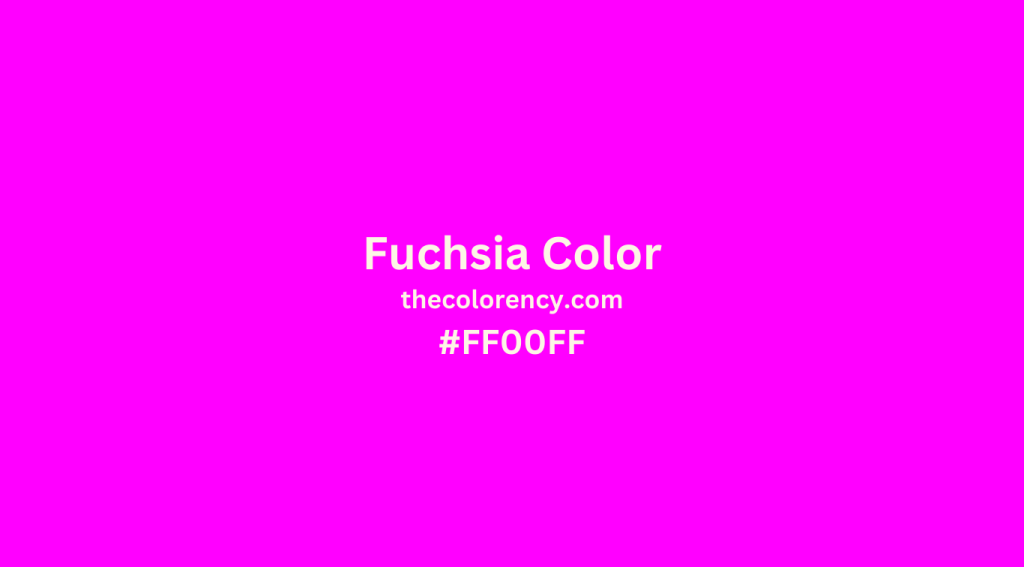
Fuchsia is a striking and vibrant shade of pink that has been popular for many years. This color has been used in a variety of contexts, from fashion to interior design to art. The hue is associated with confidence, creativity, and energy, making it a great choice for any project. In this article, we’ll explore everything you need to know about the fuchsia color, from its history to its symbolism to its contemporary applications.
What is the Fuchsia Color?
Fuchsia is a vivid pinkish-purple hue, often described as being a combination of magenta and pink. It was named after the vibrant flowers of the same name, which have been cultivated for hundreds of years. The original color of the fuchsia flower varies from deep purple to a light pinkish-purple, and the color of the fuchsia color is a more intense version of this.
The fuchsia color is a secondary color, which is created by combining two primary colors. To create the fuchsia shade, you need to mix equal parts of red and blue. This will create a deep magenta color, which can then be lightened with white to create the fuchsia hue.
Origins and History of the Fuchsia Color
The fuchsia color was originally created by mixing equal parts of red and blue. The hue first appeared in the late 18th century and was quickly adopted by artists. In the 19th century, the color was used by painters, particularly those of the Pre-Raphaelite movement. The fuchsia color was then adopted by the fashion industry in the early 20th century.
The color’s popularity increased after the invention of the first synthetic dye in the late 19th century, which made it easier to create bright and vivid colors. The first synthetic fuchsia dye was created in 1907, and it quickly became a favorite of fashion designers and couturiers. Fuchsia was used in many fashion collections in the early 20th century, and it remains popular today.
Symbolism of the Fuchsia Color
The fuchsia color is often associated with confidence, creativity, and energy. The hue is vibrant and eye-catching, and it can be used to make a bold statement. It is also a symbol of femininity and grace, and it is often used in fashion to create a romantic and delicate look.
The color is also associated with power and strength. The hue is often used to represent authority and command, and it is often used in corporate logos and branding. The fuchsia color is also often used to represent luxury and sophistication, and it is popular among interior designers and decorators.
Contemporary Applications of the Fuchsia Color
The fuchsia color is still popular today, and it is often used in a variety of contexts. The hue is popular in fashion, and it is often used in clothing and accessories. It is also used in interior design, particularly in bathrooms and bedrooms. The color is also popular in art, and it is often used to create bold and vibrant paintings.
The fuchsia color is also popular in graphic design and branding. The hue is often used in logos and advertising campaigns, and it is often used to create a bold and modern look. The color is also popular in web design, and it is often used to create vibrant and eye-catching websites.
Tips for Using the Fuchsia Color
When using the fuchsia color, it is important to consider the context in which it will be used. The hue is bold and eye-catching, and it is important to use it in moderation. The color can be used to create a vibrant and energetic look, but it is important to balance it with other colors to create a cohesive and harmonious effect.
It is also important to consider the symbolism of the color. The hue is often associated with confidence, creativity, and femininity. When using the color, it is important to consider how it will be interpreted by the audience.
Conclusion
Fuchsia is a vibrant and eye-catching hue that has been popular for many years. The color is often associated with confidence, creativity, and energy, and it is often used in fashion, interior design, art, graphic design, and branding. When using the fuchsia color, it is important to consider the context in which it will be used and the symbolism of the hue.
